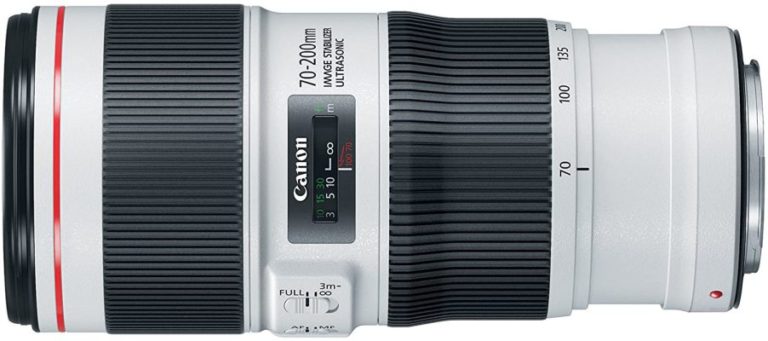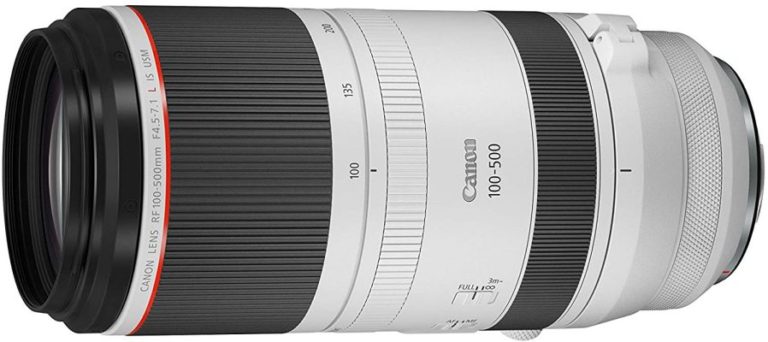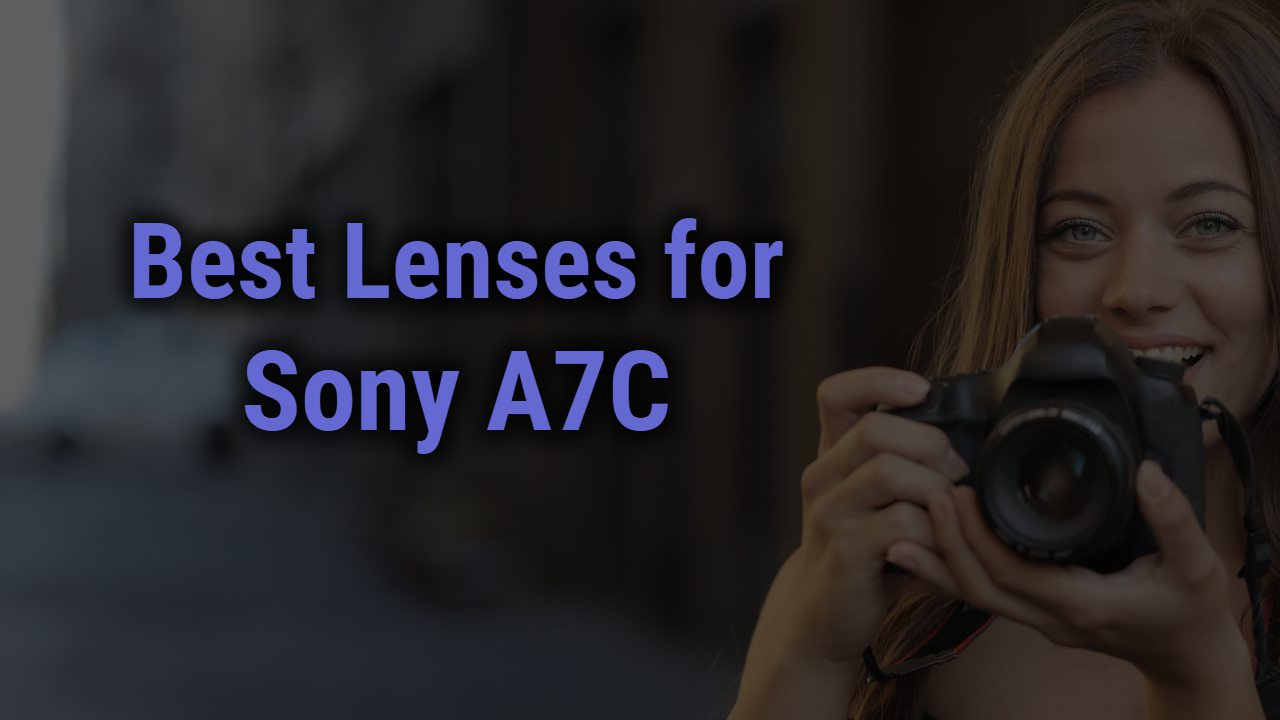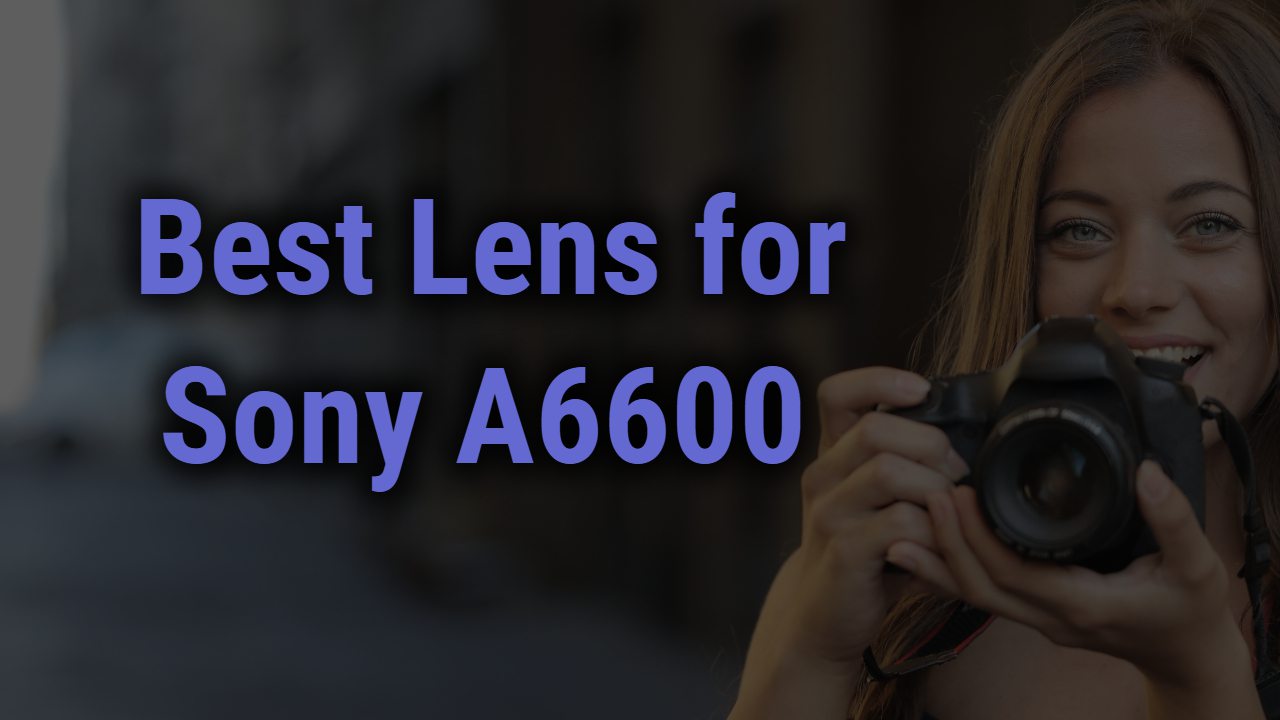If you want your photography to be perfect, you should know that choosing a lens according to the photography type is one of the most significant factors to consider. Photography style like portrait is quite regular yet creative, which means this photography will need some different and intriguing options. Canon is one of the most productive and reliable brands for digital tools; the brand offers a bunch of amusing lens options, but how to know which one is best?
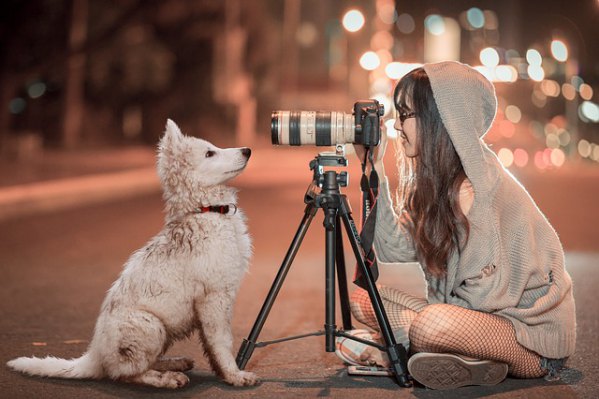
Now finding the best Canon lens for portrait shooting is a big concern for you; you need to analyze, research, and compare a bit to make the worthy purchase. There are a few characteristics of individual lenses you need to study to find the ideal lens.
But, wandering the market, scrolling websites in search of the ideal lens to pair your camera and shoot magnificent portrait photography days are literally over, and here your search comes to an end. We have analyzed the situation and compiled a list containing all the competent, versatile and wonderful portrait lenses along with their brief potential and performance. So, dig in and find out some of the best lens options for your portrait photography.
Note: You can use EF Lenses on any Canon Cameras. However, if you want to use the EF Lens on a Mirrorless Full-frame camera then you have to use the EF to EOS R adapter. Similarly, if you want to use the EF lens on a Mirrorless APS-C camera then you have to use the EOS M Mount Adapter. And the RF lenses can only be used on Canon Full-frame Mirrorless Cameras.
| Best EF Portrait Lenses for Canon |
|---|
|
1. Canon 2271C002 (Best Prime Portrait Lens)
|
|
2. Sigma 321954 (Budget Prime Portrait Lens)
|
|
3. Sigma 259954 (Another Great Portrait Lens)
|
|
4. Sigma 311954 (Cheapest Prime Portrait Lens)
|
|
5. Canon 2309C002 (Best Zoom Portrait Lens)
|
|
6. Sigma 576954 (Budget Zoom Portrait Lens)
|
|
7. Sigma 240954
|
|
8. Canon 9523B002
|
| Best RF Portrait Lenses for Canon |
|---|
|
1. Canon 3450C002 (Best Prime Portrait Lens)
|
|
2. Canon 2959C002 (Another Great Prime Portrait Lens)
|
|
3. Canon 3792C002 (Best Zoom Portrait Lens)
|
|
4. Canon 3680C005 (Zoom Portrait Lens with Short Focal Length)
|
|
5. Canon 4112C002 (Best Super Zoom Portrait Lens)
|
|
6. Canon 5050C002 (Cheapest Zoom Portrait Lens)
|
A quick Peek at the requirement you will need in your To-Be perfect portrait photography lens
Before jumping into the all-inclusive broadest piece of details, let’s have some serious consideration of little facts you need to configure or analyze in your ideal future portrait lens. Later you will find the justification and other points to consider below in the article.
- Aperture– Portrait photography requires a wide aperture that ensures balanced sharpness around the frame center and corner.
- Depth of Field– This photography needs a shallow depth of field for more highlighted subject
- Focal length – Portrait photography needs the longest reach to trap the farthest subject in the frame
- Coverage– Choose either full-frame or APS-C coverage, both works fine. Only the APS-C camera has the privilege of enhanced focal length, or we say equivalent focal length (crop factor effect)
- Mount– Choose EF or RF mount according to your present portrait camera mount; R-series canon camera goes for RF lenses while EF lenses are for EOS SLR and digital camera family.
This Post Contains
Best Canon EF Lenses for Portrait Photography
1. Canon EF 85mm f/1.4L IS USM
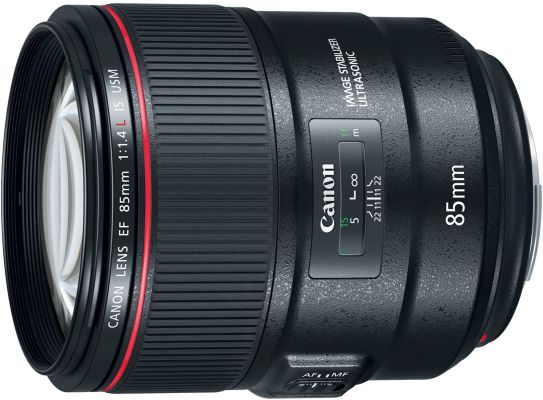
Checkout on
Amazon | B&H Photo Video | Adorama | Canon USA
Known for its creative character and fastest optics, Canon EF 85mm lens is a dream lens for portrait images; the short telephoto reach, prime abilities, and sophisticated physics is admired and well-suited to the professional and beginner photographer.
Lens Type– Prime Lens
Compatibility– EF lens
Brand– Canon
Why is it best for portrait photography?
Canon EF 85mm lens is an excellent piece for portrait photography because of its short telephoto reach, with the focal length of 85mm capturing the farthest distance. Due to the crop factor, the lens can also get you the longest distance of 136mm when paired with an APS-C camera.
Focusing:
With the courtesy of a ring-type ultrasonic motor, users get to experience fast, precise, and silent focusing with a performance range of a minimum distance of 2.79 inches and a maximum magnification of 0.12x. Also, the full-time manual focus override makes things more creative while shooting a stationary or moving subject. The nine-diaphragm blade covers the out-of-focused area with an artistic effect.
Optics:
The notably fastest f/1.4 constant aperture of this lens gives corner-to-corner sharpness; and is also responsible for the greatest depth of field, which certainly gives your portrait a nice blurry back. To minimize the distortion, the lens has a one-glass molded aspherical element, fourteen elements in ten groups, and air sphere coating.
Creative Additional:
While on top of all, the optical image stabilization of the lens compensates for the camera shakes for up to four shutter stops, managing the image free from blurriness.
Engineering:
The lens certainly is a collection of esteemed L-series, which explain the strong configuration and smooth front fluorine coating to protect the outer from smudge, fingerprints, and water splash. The lens is easy to handle and store and is associated with the least weight of 950 grams only.
2. Sigma 105mm f/1.4 DG HSM Art for Canon EF
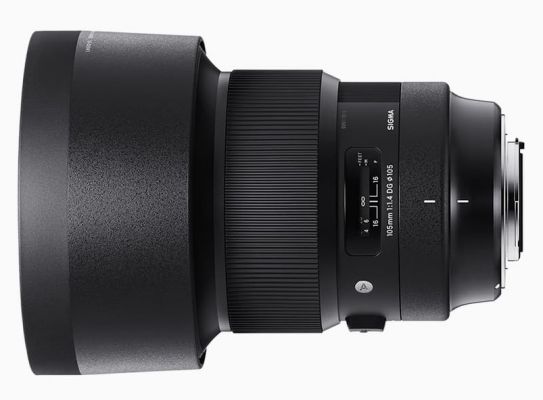
Checkout on
Amazon | B&H Photo Video | Adorama | Sigma
One of the most attractive labels this Sigma 105mm lens received is its no-holds-barred approach which is designed for convenience and creativity. The advanced optical layout, intuitive control, and immense versatility have proven its best claim for portrait photography.
Lens Type– Prime Lens
Compatibility– EF lens
Brand– Sigma
Why is it best for portrait photography?
Again, the no-hold-barrel, the short-telephoto range, and the prime lens supremacy are perfectionists for portrait shots. The Sigma’s global vision series launched lens is curated with the potential to shoot with 105mm focal length with full frame and even better 168mm with the APS-C; the longer the length, the more artistic portrait shot you get.
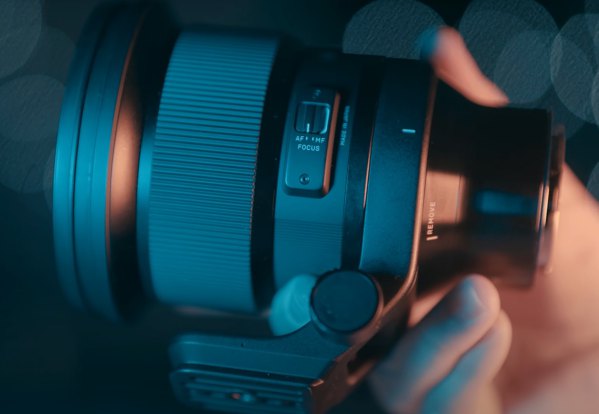
Focusing:
The lens configuration has the Hyper Sonic Motor that provides optimized silent, fast, and precise AF, which certainly works with a minimum distance of 3.28 inches and a maximum magnification of 0.12x. The nine-diaphragm blade creates a pleasing bokeh filter making your portraits attractive.
Optics:
The impressively bright and constant aperture of F/1.4 or the large diameter of 105mm opening manages the improved peripheral illumination to create sharp imagery. This also gives a wider depth of field, supportively giving a more blurry background target on the subject slaying portrait filming. Additionally, three F low dispersion elements, two special low dispersion elements, one aspherical element, and a super multi-layer coating were injected to avoid distortion.
Creative additional:
The engagement of a specialized electromagnetic aperture works hardest to grant greater exposure control stability throughout the shot. In addition, the lens includes a rotating tripod collar which allows the pairing of an arca-type compatible tripod to avoid handheld usage and approach comfortability. The lens also has a lens hood which keeps the lens lightweight and manages its security.
Engineering– the lens’s outer body is constructed with a thermally stable composite and traditional metal for precision and accuracy. The brass bayonet mount assured the strongest grip over the lens, and all that is protected with a rubber sealing and fluorine coating to protect it from dust and splash.
3. Sigma 135mm f/1.8 DG HSM Art for Canon EF
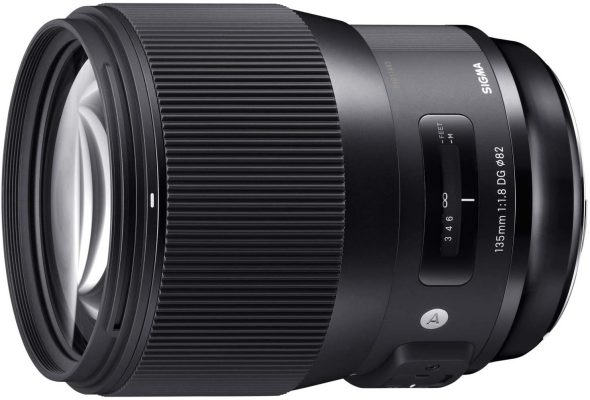
Checkout on
Amazon | B&H Photo Video | Adorama | Sigma
Another masterpiece is a fast telephoto reach lens with prime premium abilities; yes, this Sigma 135mm lens comes quite handy for shooting extraordinary images. The intuitive handling, user-friendly interface, and design are way more perfect for shooting live portraits
Lens Type– Prime lens
Compatibility– EF lens
Brand– Sigma
Why is it best for portrait photography?
First, the lens is launched in Sigma’s Global Vision series, which gives it the privilege of effective features and a telephoto reach. The full-frame camera attachment can avail 135mm focal length, while the APS-C format can get you 216mm length to frame the subject ideally farthest away.
Focusing:
The lens is associated with an in-built enormous Hyper Sonic Motor that works for the fastest and better AF and also the responsive full-time manual focus override. The focusing can be managed within a certain range that is subjected to be 0.287 inches at a minimal distance and 0.3x maximum magnification. To cover the back and unattractive and unfocused area, the nine diaphragm blades craft a pleasing bokeh.
Optics:
The bright constant aperture of f/1.8 is suited best to work in low-light conditions with the greatest control and provides extensive sharpness and illumination. For exposure and clarity management, the lens uses the sharp optical elementary, including two F low dispersion and two special low dispersion elements along a super multi-layer coating.
Engineering:
The lens body is rigidly durable due to the thermally stable composite material and brass bayonet mount, and other traditional metals. The front protection layer keeps the dust or splashes away from affecting your portrait, and the lightest weight of 1130 grams manages convenience throughout the shoot.
4. Sigma 85mm f/1.4 DG HSM Art
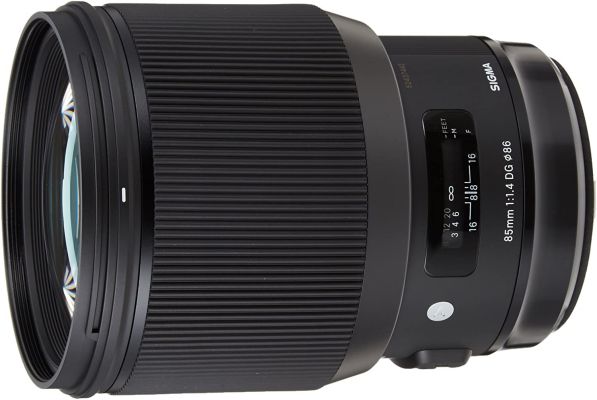
Checkout on
Amazon | B&H Photo Video | Adorama | Sigma
The well-known and productive brand Sigma has introduced this wonderful Sigma 85mm lens destined to deliver a sharp optic with the highest performance, but the best part is it does take care of your comfort and ease during the shooting of crisp and clear images and that all under a reasonable price.
Lens Type– Prime Lens
Compatibility– EF lens
Brand– Sigma
Why is it best for portrait photography?
The lens’s prime abilities and supremacy of technologies are best for portrait shooting; the telephoto reach of 85mm focal length and 136mm equivalent focal length also gives a hand in framing magnificent portrait shots, ideally focused on the subject with an artistic approach.
Focusing:
The injected Hyper sonic motor engages in giving the thrilling experience of quick, quietest, and most accurate AF along the traditional but more responsive full-time manual focus. The focusing specialty can be applied within the minimum distance of 33.46 inches with a maximum magnification of 0.12x. You can expect a professional effect in the frame with the appealing bokeh filter through the rounded nine-diaphragm blade.
Optics:
Optics is another significant factor that proves the lens worth in portrait shooting; the fastest f/1.4 maximum aperture spreads not only edge-to-edge sharpness but also provides shallow depth of field, just what you need. For image sharpness balanced, the lens incorporated two SLD elements, one element with a high rate of anomalous partial dispersion and one aspherical element. Super multi-layer coating deals with the ghosting and flares stuff.
Engineering:
Like any other model, the Sigma 85mm lens also has a rigid, thermally stable composite material configuration. The lens also assures safety with the brass bayonet mount. Like others, all outer infrastructure and controls are protected against toxic weather elements. The lightest weight of the lens is 1130 grams; make sure you don’t feel the heavy weight while keeping an eye on the subject for the longest time.
5. Sigma 50mm F1.4 Art DG HSM Lens for Canon
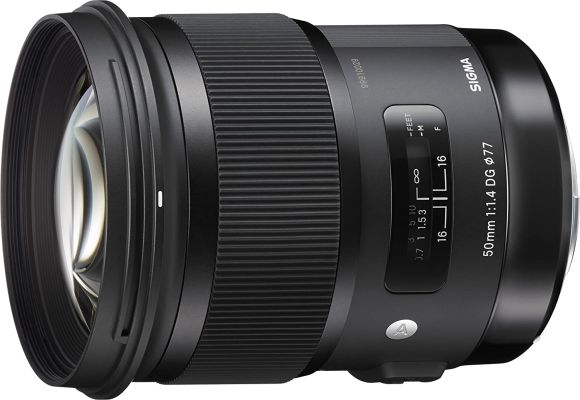
Checkout on
Amazon | B&H Photo Video | Adorama | Sigma
If we are talking about a versatile and effective lens, there is no way we cannot mention this masterpiece of Sigma, the Sigma 50mm HSM art lens. The lens is designed to unveil the best crisp and sharp footage, one that can add a charismatic effect to your shooting skills. The prime abilities and performance are quite fascinating at a reasonable price.
Lens Type– Prime Lens
Compatibility– EF lens
Brand– Sigma
Why is it best for portrait photography?
First, the lens is designed with the sole motive of achieving sharpness, resolution, and professionalism; the ideal 50mm focal length and 75mm equivalent focal length are an addition to its agenda. There are several intelligent features that aesthetically prove worth suiting portrait pictures.
Focusing:
Like the others, this one is also associated with the powerful Hyper Sonic AF motor that works hardest to provide a fast, accurate, and smoother AF and full-time manual focusing; focusing comes with a 1.31-inch minimum distance range and 1:5.6 maximum magnification. Nine rounded diaphragm blades were injected for the bokeh filter.
Optics:
For balancing the exposure, the lens has a bright f/1.4 aperture and a large 85.4 diameter opening that grants extensive peripheral brightness and clarity, plus a shallow depth of field. Their special low dispersion element and super multi-layer coating keep the distortion away from the imagery.
Creative Additional:
The molded glass has aspherical elements that work with Croma flare while an advanced optical structure works for greater resolution. This also has the creative potential to separate the focused subject and out-of-the-focus back and grant a perfect vision of portraits. It also has an additional floating system to manage the adjustment of glass elements, eventually reducing the lens movements. Included lens hood measures the fitting and security.
Engineering:
The lens physics is considerably strongest that is made up of thermally stable composite and traditional metals; the strongest brass bayonet gives utter strength while the security is all under the front fluorine coating hand. No hazardous element or terrible weather can bother you anyway; the lightest 815-gram weight is the cherry on top.
6. Canon EF 35mm f/1.4L II USM
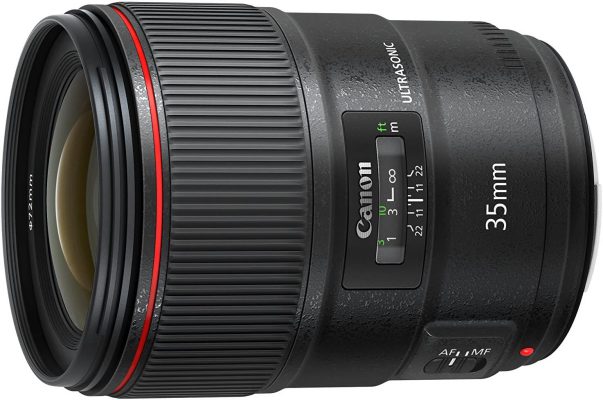
Checkout on
Amazon | B&H Photo Video | Adorama | Canon USA
Don’t wander around searching for a perfect lens; bring home this Canon EF 35mm lens for perfection. The lens with enormous power and creative aspect; the lens aims for resolution and sharpness. Yes, the highly versatile line with prime premium abilities is suited best to capture portraits.
Lens Type– Prime Lens
Compatibility– EF lens
Brand– Canon
Why is it best for portrait photography?
The Canon EF 35mm, a wide-angle lens with prime abilities, is one of the dominant factors that grant the fastest performance. The lens is designed for portrait photography, as explained by the 35mm focal length and equivalent 56mm focal length with APS-C format. Complementing imageability, the lens has intelligence that guarantees professionalism.
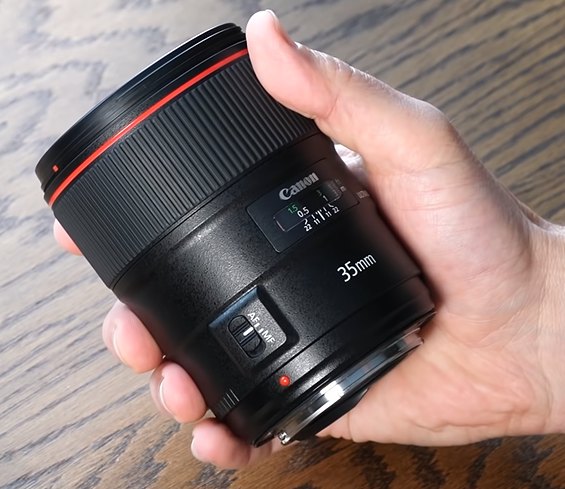
Focusing:
The involvement of a Ring-Type ultrasonic Motor assures the fastest, most precise, and near-silent Autofocusing and full-time manual focusing. The focusing is ranged within a certain number, the focusing distance of 11.02 inches at minimum and magnification of 0.21x. The lens includes nine rounded diaphragm blades that cast away a beautiful blur back.
Optics:
The fastest, constant f/1.4 aperture grants the benefits of working in a dark environment with better illumination; the wide aperture collaborates to an optimized depth of field control, slaying the target subject framing. The aspherical element pair and UD element work on the distortion and aberration stuff, while the sub-wavelength coating is applied for ghosting and flare.
Creative Additional:
Another blue spectrum refractive optics indulge in minimizing the color fringing and making sure your frame matches color neutrality through refracting wavelength.
Engineering:
The lens is launched in the popular esteemed L-series, which assures durability, strength, and security. The upper fluorine coating is implied to protect the optical system, smudge, and fingerprint. The lens has the lightest weight of 760 grams.
7. Sigma 24-70mm f/2.8 DG OS HSM Art for Canon
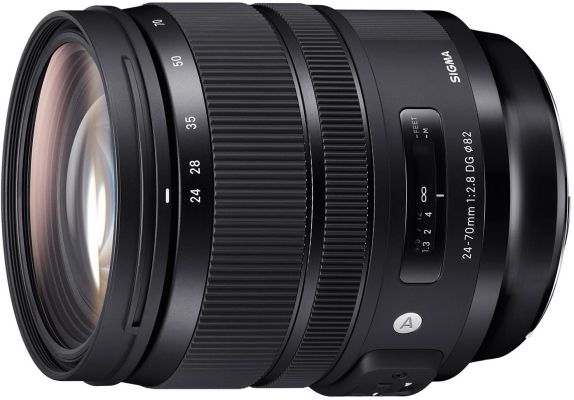
Checkout on
Amazon | B&H Photo Video | Adorama | Sigma
Named and Famed for its versatility, the useful wide-angle lens is the first zooming lens in the category that gives suited opportunity to capture sharp and out-of-the-world shots. The lens’s immense abilities and performance all come under a quite reasonable price tag which is the additional cherry on top.
Lens Type– Zoom Lens
Compatibility– EF lens
Brand– Sigma
Why is it best for portrait photography?
The lens is designed to deliver a mingled effective performance considering convenience and creativity. The lens is launched in the Sigma iconic collection Sigma’s Global Vision series. The creative aspect of the lens allows shooting the farthest away subject with a focal length of 24-70mm and 38.4-112mm equivalent focal length.
Focusing:
The internal Hyper Sonic Motor grant guarantees the experience of fast, precise, and smooth autofocusing and full-time manual override. The optimized focusing is tied with a minimal range of 1.24 inches with a maximum magnification of .21x. The durable nine diaphragm blade has a cast bokeh filter to highlight the subject.
Optics:
The bright aperture f/2.8 works best for establishing the corner-to-corner sharpness and clarity, backed up with the other three special low dispersion elements and four aspherical elements to polish the contrast and color. The very best is the shallow depth of field, which ideally grants you the privilege of shooting wonderful portrait shots.
Creative Additional:
The lens has the additional involvement of an optical stabilizer that is powered to eliminate the camera shake by up to four stops benefitting with sharp, balanced, and smooth images.
Engineering:
The lens body is composed of polycarbonate, and its control dials are made of carbon feathers. The whole body is covered with a fluorine coating, which keeps the water, and oil splashes farthest away from the lens or camera. The lightest 1020-gram weight manages the convenience and ease of portability during filming.
8. Canon EF 70-200mm f/2.8L IS III USM
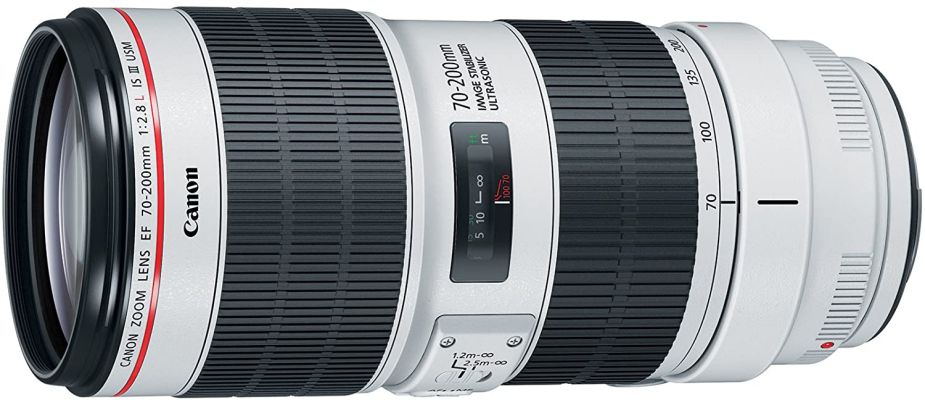
Checkout on
Amazon | B&H Photo Video | Adorama | Canon USA
We can’t forget to mention Canon EF 70-200mm lens, a magnificent zooming lens competitor; the lens is associated with the most versatile character and advanced optics that complement the lens shooting abilities.
Lens Type– Zoom Lens
Compatibility– EF lens
Brand– Canon
Why is it best for portrait photography?
There’s a lot we can list here that proves the lens worth in portrait photography. Being one of Canon’s masterworks, the lens is able to allow you to shoot with 70mm to 200mm focal length; when paired with any APS-C format, the lens gives out 112mm to 320mm equivalent focal length. The lens’s consistent performance and ability set goals of professionalism.
Focusing:
There is much more to the lens’s focusing system; it uses the potential of the ring-type ultrasonic motor algorithm in order to deliver fast and accurate focusing. The focusing distance of the lens is measured to be 3.94 inches minimum, and the magnification can be done with the maximum range of 0.21x. The lens includes eight diaphragm blades to cast beautiful bokeh to leave unattractive areas in the frame.
Creative Additional:
There is an additional Focus Limiter Switch that constrains the focusing and finds a suitable range of distance from 3.9 inches to infinity. It also has an intuitive optical image stabilizer that reduces the camera shake by minimizing up to 3.5 shutter speed and handles the task better in low-light conditions. Another additional tripod collar involvement is new, which allows attaching the tripod and monopod, eventually keeping the lens from moving or shaking during the shot.
Optics:
The lens has the engagement of numerous effective elements, including one fluorite element, five ultra-low dispersion glass elements, and an air sphere coating that is applied to reduce the distortion. The bright f/2.8 ideal aperture gives better illumination and better control over depth of field, which is everything a portrait filming needs.
Engineering:
The lens body is made up of industrial-graded material, and all the control and dial are a shield with the front fluorine coating acting almighty to the fingerprint, smudging, and splashes. The lens’s ease of handling, ergonomic and lightest weight of 1480 grams keeps the maneuverability in check.
Best Canon RF Lenses for Portrait Photography
9. Canon RF 70-200mm F2.8 L IS USM
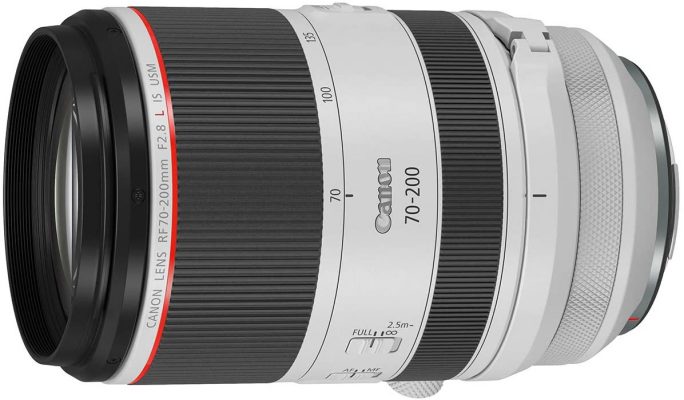
Checkout on
Amazon | B&H Photo Video | Adorama | Canon USA
You can’t question the impeccable competency of the Canon RF lens; and so, with this extraordinary Canon RF 70-200mm lens. This lens has the potential to meet your creative expectation without spending a lot, and that too under a decent price tag.
Lens Type– Zoom Lens
Compatibility– RF lens
Brand– Canon
Why is it best for portrait photography?
The exclusive lens launch in L-series explains its higher abilities; it is potent enough to get a closer view of the faraway subject with its telephoto reach length. The lens’s 70mm to 200mm focal length is quite creative to offer you a marvelous portrait.
Focusing:
The potent Dual Nano USM motor has a distinctive but supreme ability to utilize both a ring-type USM and an STM mechanism that grants quick and accurate autofocusing with full-time manual focus control. The focusing distance offered by the lens specifies from 2.7 inches minimal with 0.23x magnification maximum. The nine-diaphragm blade covers the back with bokeh artistic vibes.
Optics:
You can’t doubt the optics of this lens; the bright f/2.8 aperture manages the consistency of lighted and sharp images under any dark or zoomed range scenario. The higher control over the depth of field gives a pro-leveled blurry back view.
Creative Additions:
The lens has a special optical image stabilizer that minimizes the camera shake by five shutter speed stops; the lower shutter speed is also the reason why this lens is perfect for portrait shooting. The lens is ideally categorized into three Stabilization modes to work on, standard single-shot, panning-optimized, and an exposure activation mode enhancing lens versatility. There is a customizable control ring engagement that carries basic control dials to avoid hassle during the shot. Additionally, a focus limiter switch in the lens manages the distance. The lens also has a tripod collar for tripod and monopod attachment.
Engineering:
The lens’s strongest body is covered with weather-resistant factors, ensuring security. The vibration shock resistance in the lens barrel maintains the focus during the portrait shot. The lens front and rear, both of the outer layer, are shielded with an effective fluorine coating to prevent smudging and splashing stuff, and the designed body grabs at least 1070 grams of weight.
10. Canon RF 85mm F1.2 L USM
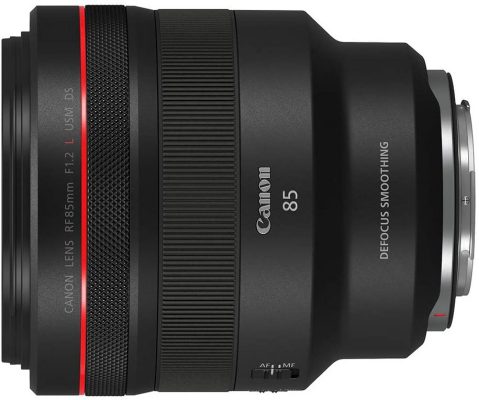
Checkout on
Amazon | B&H Photo Video | Adorama | Canon USA
Now let’s again move to the prime category; the ultimatum of trouble and unprofessionalism. Starting with this spectacular Canon RF 85mm lens, the lens incorporated smooth performance, exceptional abilities, and sophisticated design, best within a reasonable price.
Lens Type– Prime Lens
Compatibility– RF lens
Brand– Canon
Why is it best for portrait photography?
A unique approach of short telephoto reach and prime supremacy is what defines this lens adequately. The lens is designed to bring the artistic imagination, in reality, shoot portrait imagery with ideally 85mm focal length covering the longest reach of the shooting scene. Other additional features and optical layout works fine for the filming.
Focusing:
The lens offers highly responsive focusing with a minimum range of 2.79 inches and a maximum magnification of 0.12x. The intuitive ring-type ultrasonic motor with optimized control is employed to deliver the fastest, precise, and near-silent autofocusing along with the full-time manual focus override. Rest is taken care of by the engagement of nine diaphragm blades.
Optics:
In the lens optical design, one aspherical element and one ultra-low dispersion element, along with one blue spectrum refractive optics element, indulge in providing greater clarity while air sphere coating reduces backlit stuff. The brightest and constant aperture of f/1.2 opens wide to grant lighter subjects affording an extensive depth of field for creative artistic vision.
Creative Additional:
Additionally, a control dial that can be personalized as per the requirement with basic settings like exposure, ISO, and others is configured, giving ease during filming.
Engineering:
With the exclusive launch in the crucial collection, the outer lens body is quite rigid, while the security is all in the hand of fluorine layering at the front. The lens’s sturdy body only weighs 1195 grams; only that comes in handy when it comes to easy portability, video shot, or storage.
11. Canon RF50mm F 1.2L USM
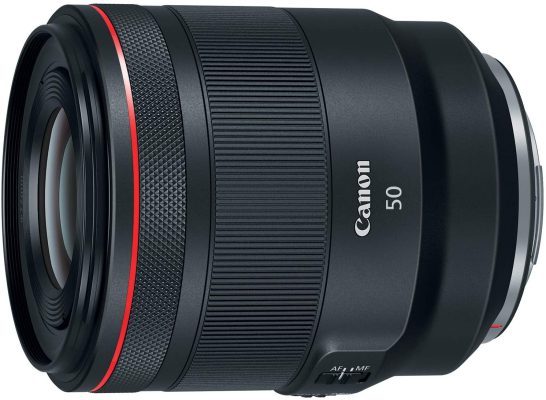
Checkout on
Amazon | B&H Photo Video | Adorama | Canon USA
An iconic addition, an excellent lens with desirable normal length, wide-angle perspective, and prime supremacy. The fastest lens with supreme intelligence and fascinated performance under a decent price range is quite a show in the market.
Lens Type– Prime lens
Compatibility– RF lens
Brand– Canon
Why is it best for portrait photography?
What one must look for in the portrait shooting lens are the ideal focal length and several advanced abilities; this one has it all. A normal-length prime lens is able to catch the farthest view with the 50mm focal length. The higher depth of field is also a perk in shooting a portrait within any selective focusing technique.
Focusing:
The enormously powered ring-type ultrasonic motor is optimized for fast and better autofocusing employed with a certain range of 1.31 inches with the 0.19x maximum magnification. The full-time manual focus override also comes attached with its specification. The lens has the engagement of a ten-rounded diaphragm blade that contributes a pleasing bokeh to the frame.
Optics:
In terms of optics, the lens manages an exceptionally bright aperture of f/1.2 that grants extensive control over depth of field, ultimately getting you the best portrait shot. One Ultra-low-dispersion element and one aspherical element manage the rendering and color, while the layering does manage the ghosting and backlit stuff.
Creative Additional:
Like Canon’s effective model, this lens also includes a distinct control ring that can be personalized for basic settings to ease the hassle and maintain convenience during the shot.
Engineering– The lens has the strongest body and the lightest weight of 950 grams. Tackling the hazardous climate and dirt material, the front fluorine coating manages to keep the toxic away from the lens and camera body.
12. Canon RF100-400mm F5.6-8 IS USM
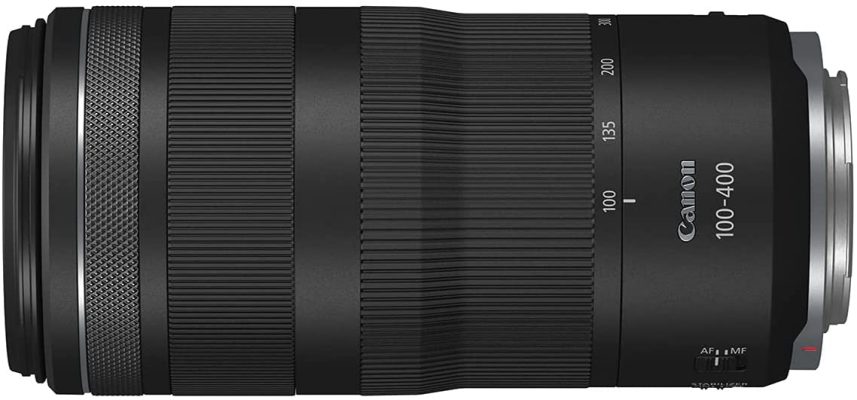
Checkout on
Amazon | B&H Photo Video | Adorama | Canon USA
Moving towards another masterpiece, the Canon RF 100-400mm lens intends to set a perfect example of creativity and convenience together. The offered versatility and optical performance are suited best for the portrait of wildlife, sports, and even fast-moving travel subjects.
Lens Type– Zoom lens
Compatibility– RF lens
Brand– Canon
Why is it best for portrait photography?
Portrait image shooting requires a longer focal length or reach, and telephoto categories are just a cherry on top of that. This Canon RF 100-400mm lens is powered enough to shoot the farthest away subject with the 100mm to 400mm focal length with better zooming range; ideally, the portrait shooting needs.
Focusing:
The potent Nano USM system inside the lens manages the ring-type USM and STM motor mechanism that convert their ability to provide a smooth, silent, and better focusing in photo and video. The focusing ability of the lens is limited, with a minimum focusing distance of 2.9 inches and a maximum magnification of 0.41x. Apart from them, the nine-diaphragm blade casts a magnificent blurry back effect in your portrait.
Optics:
Quite impressive optics of the lens are all results of a versatile aperture, the aperture that can be adjusted from f/5.6 to f/8 according to the need of lighting. But that’s not it; the advanced optical elements like ultra-low dispersion and aspherical elements with super spectra coating ensure the frame does not align with the distortion and aberration stuff.
Creative Additional:
The lens involves a configurable control ring that is associated with basic settings and lean to provide comfortability during the shot. Additionally, the lens has an optical image stabilizer that eliminates the threat of jiggering or turbulence caused due to camera shake by reducing shake by 5.5 stops.
Engineering:
The firm outering and shielded control is the doing of the lens’s strongest composite material; the rigid hold is part of the same. You have to worry less about the weather-toxic element, all thanks to the front layering. The lens does not leave a strain on your hand during longer hours of shooting due to its least 635 grams weight.
13. Canon RF 100-500mm F4.5-7.1 L IS USM
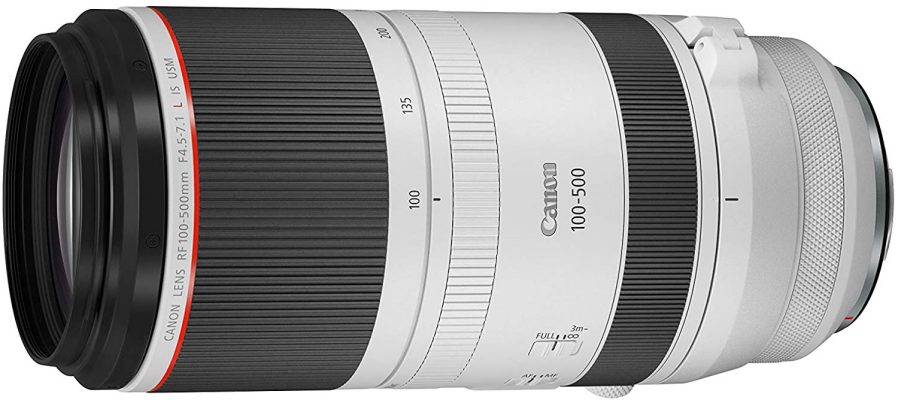
Checkout on
Amazon | B&H Photo Video | Adorama | Canon USA
Balancing the ease of shooting and taping artistic imagination in the frame, this Canon RF 100-500mm came a long way. The lens covers a variety of unrivaled features like the longest portrait reach, stability, additional intelligence, and much more, all that for a reasonable range.
Lens Type– Zoom lens
Compatibility– RF lens
Brand– Canon
Why is it best for portrait photography?
One of the major reasons to buy this lens is its super telephoto reach; this outstanding lens grants you the magical power to get a close view of the farthest steady subject with its 100mm to 500mm focal length to capture never seen shots. That’s not all; it has better settings and controls that ease you to adjust the zoom range, manage exposure and get a better portrait view.
Focusing:
The lens offered to use its mastered focusing with a minimum range of 2.94 inches and 0.33x maximum magnification. The configuration of a Dual Nano USM system that intendedly to use both a ring-type USM and STM motor mechanism to deliver quick and accurate Auto and full-time manual focus. The involvement of nine diaphragm blades takes care of the bokeh.
Optics:
The lens allows the versatile adjustment of aperture, initiating from the range f/4.5 to f/7.1. Accordingly, the dark or bright surroundings manage a better depth of field. Complementing the quality, it includes six ultra-low dispersion and one super Ultra-low dispersion element providing greater clarity and color.
Creative Additional:
The optical image stabilizer bestows the magic of steadiness and balance by compensating the camera shake with five shutter speed stops and is categorized into three distinct modes. The lens has an additional configurable control ring with a basic yet variety of exposure settings to use during the shot. It comes with the lens hood included for security, easy adjustment of filters, and grip. The lens is also blessed with an additional tripod collar for the attachment of the tripod and monopod, and it does have a rotation-type zoom ring that eases the torque adjustment for fine-tuning and securing the lens grip.
Engineering:
Due to the lens esteemed L-series launching, it gets the strongest, most durable, and most reliable construction. The lens has a front fluorine coating that manages to keep the toxic, harsh climate element and fingerprints away. The lens’s lightest weight of 1365 grams manages portability.
14. Canon RF 24-70mm F2.8 L IS USM
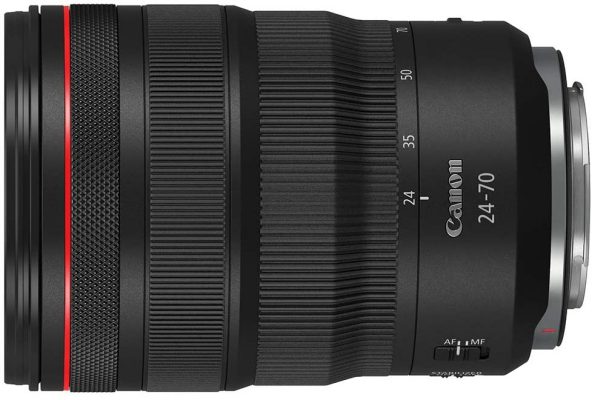
Checkout on
Amazon | B&H Photo Video | Adorama | Canon USA
Last but not least, a super convenient lens with loaded versatility, intuitive design, and determination to trap creativity, and yes, Canon RF 24-70mm have intendedly much more to offer within the least price tag. The lens’s amusing abilities and controls will leave you fascinated all way long.
Lens Type– Zoom lens
Compatibility– RF lens
Brand– Canon
Why is it best for portrait photography?
The standard zooming lens Canon RF, 24-70mm, has immense abilities; designed for portrait shots, it gives you the power to shoot the longest reach by adjusting the zooming range between 24mm to 70mm when paired with a full-frame camera. The sharpness and clarity of the shot of the lens are none less than your dream-come-true shot.
Focusing:
The Nano USM system uses the potential of ring-type USM and STM mechanism to bestow the fastest, smoothest, and most accurate focusing; embark on shooting within the minimum focusing distance of 8.27 inches and a maximum magnification of 0.3x. The nine-diaphragm blade was injected to craft a beautiful bokeh filter in the frame, charming the appearance.
Optics:
The constant and bright f/2.8 maximum aperture manages the illumination through the dark hour of shooting and also increases the depth of field, which ideally unleashes the opportunity of getting flawless portraits. On top of that, it includes three Ultra-low dispersion and three aspherical elements along air sphere coating for image correctness.
Creative Additional:
The optical image stabilizer is indulged in to minimize the camera shake by five stops, eventually exposing the balanced and steady shot. The lens is blessed with a configurable control ring, which can be customized according to your need to avoid interfering with the main camera setting.
Engineering:
The convenience of the lens is defined by the ease, ergonomic and lightest weight of 900 grams. The protective fluorine coating is implied to the front and rear that keeps the fingerprint and smudges away. The strongest body of the lens is the result of top-notch elements, and durability is one of the factors that came out of it.
Important terms to know about the Canon lenses
Let’s take a short break; before you get to the whole buying guide part, we must ensure you get all the detailed information about the lenses correctly. So here are some significant short terms and values used above and used in any canon lenses, and combinations you should know off.
Abbreviation– So these short abbreviations have a comprehensive meaning.
- EF– Type of lenses, designed for the Canon EOS full frame or APS-C camera models
- RF – Type of lenses designed for the Canon EOS full-frame R-series camera models
- USM– It’s stated as an ultrasonic motor. A Canon special focusing motor provides a fast and silent focusing experience
- STM– It’s stated as a stepper Motor, a Canon special focusing motor designed to reduce Autofocusing vibration and give the silent shot
- IS– Used for Image stabilization, a technique that reduces the camera shake
- L-Series- Subjected for the “luxury” series, the highest standard and prof-grade lens collection launched by Canon
- AF– Used for the Autofocusing
- MF– Used for the Manual Focusing
Value– Apart from the confusing abbreviations, some values might also confuse you.
- (N)mm– Defines the focal length range like 50mm, 85mm
- F/(n)– Defines the aperture range like F/2.8, F/4
- (N) inch – Defines the focusing distance like 33.46-inch, 2.96 inch
- (N)x– Defines the magnifications like 0.3x, 0.21x
- (N):(N)– Defines the Magnification ratio like 1:5.1, 1:4
- (N) gram – Defines the lens weight as 680 grams, 920 grams
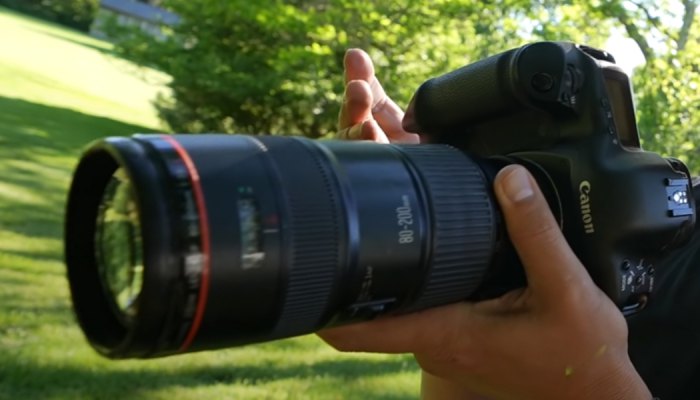
What to Look for while buying a Canon lens for portrait photography?
You might be wondering how easily we have recommended these effective and versatile lenses, but have you ever got curious about how we examine these lenses? See, getting yourself a brand-new lens is not something you put on your daily grocery list, so you might need your undivided attention on how to choose one rightful and perfect lens that makes portrait filming easy, creative, and worthy of every penny. So look out for this significant factor one should always determine before buying a portrait lens.
Sensor– The sensor is crucial to determine before buying the lens. The sensor is the brain and heart, so it is important to know what type of sensor your camera has and whether it is compatible with your lens or not. The sensor is categorized on the basis of their size; two of the major you must know is
- Full-Frame– Full-frame is the maximum image sensor size that definitely has a better resolution, better performance, fastest working, and minimal noise
- APS-C– APS-C or cropped sensor is the narrower one with a lower angle of view, but it is a lot cheaper than full-frame, and it has the easiest working and handling
Sensor size and eventually its types must be chosen correctly for the compatibility and image quality check. Because it’s essential, the largest sensor has a bigger pixel that transforms into a higher resolution. So go for the bigger or, must I say, Full-frame sensor for quality.
Lens Type – Before jumping on the lens, one must be sure what they desire to purchase. In short, you must know which type of lens you will be buying to get the best portrait shot.
Zooming ability– According to zooming potential, there are two different types of lenses defined: Prime and zoom. So ideally, you know prime, and zoom lenses are the two most significant lens types and also chaotic to choose specifically when it comes to portrait.
- Prime– Prime lenses are known for their potential to capture quality pictures. They have fixed focal lengths, and they can’t allow for zooming in or out. However, they have the widest aperture, which means lesser distortion and higher quality, ultimately sharpest imagery. The prime lenses are also the fastest and better performer due to easy building and configuration. Prime lenses are cheaper than Zoom.
- Zoom– Zoom lenses are well-known for their versatility, yes, prime may be premium, but nothing can beat the unquestionable abilities of zoom lenses. They grant freedom to try out the different focal lengths by adjusting them, simply zooming in and out. Not just that, they are highly versatile and determined to have smart sensors and intelligent features, but they are large, heavy, and complex to handle. Zoom lenses are more expensive than prime.
Both prime and zoom lenses are perfect for portrait filming, prime for image quality and aperture, and zoom for versatility; you can pick either of them as per your requirement and budget.
Focal length– According to focal length, the lens divides into numerous categories, but some of the major ones you should know are.
- Standard- The medium range of focal length lens from 35mm to 70mm
- Wide-Angle- The wide or lesser range of focal length from 24mm to 35mm
- Telephoto- The lens with a longer focal length ranges from 70mm to 200mm
- Super Telephoto- The lens with the highest focal length ranges from 200mm to 600mm or sometimes 800mm
Choose according to the distance range you want to shoot from or how much focal length you will need in your portrait shot. Do not unnecessarily pick something that you don’t require.
Aperture– Aperture usually defines the amount of light that enters the lens and falls on the subject. The aperture is the dominant factor that decides your portrait shot quality, sharpness, and crispness. There are two things you will see during the aperture analysis.
F-Stop Number– The aperture is measured in the F-stop number; this describes the amount of lens opening and light allowed onto the sensor, for example, F/1.4, F/2.8, F/8, or F/22. The lower the F-stop number will be, the wider or lighter you will get on the subject. For instance, F/1.4, the lowest number, has the widest aperture and a high amount of light, while the greatest F/22 has a narrow aperture and very less lighting on the image. Since portrait needs edge-to-edge sharpness and illumination, go for a wider aperture (Narrow F-stop)
Remember Wide Aperture = Lowest F-stop number
Depth of Field– The aperture not only decides the lighting on the subject, but it can also give you an idea about the depth of field. The depth of field is the focused area in the frame. Higher DOF means all frames are in focus, while shallow DOF means little area or subject in focus, sharpened while the background has a blurry smooth texture. In a portrait, one should need a focused subject and background blur; this can be achieved by a shallow depth of field that can be obtained by the wider aperture. So choose wisely
Remember Wide Aperture = Shallow Depth of Field
Focal length– Focal length usually terms the optical focus distance of the lens and the image sensor; it can help you decide how long or short the view you will be able to get in the lens. Focal distance is measured in mm. Portrait photography requires a better version of the subject from the farthest away, which can be only possible by the longest focal length. The longest focal length, like 200mm, gives the closest view of the subject and tape magnificently by blurring the other obstacle in the frame. This is why Telephoto lenses are considered the finest option for portrait filming.
Focus – Focusing is another significant factor to determine carefully; you can’t afford to be mistaken in focusing if you desire a pro-like shot from your lens. There are a few dominant focusing factors you have to look for during the analysis.
- Focus distance– The last thing you would want is to get blurry portrait photos, so for quality focus, don’t forget to check the minimum focus distance of the lens. This measures in inches, and it defines at what minimum range you can shoot without disturbing or losing focus. Choose the lowest value for a valued and crisp result.
- Focus mode– Before making any decision, one must figure out what focusing mode the lens supports. You need to make sure it has both Auto and Manual focusing on getting the best portrait shot with whichever mode you will be needing. AF is best for shooting, while MF is proven worthy for videography.
- Magnification– Magnification justifies how large your subject is or how large you can get the view of the subject from the farthest in your lens. So, check the magnification range offered by the lens to get the large or close (life-size) imagery. No need to pick a lower magnification rate for the closed version
- Focusing motor– Once you have figured out the different modes your lens supports, the next thing you will consider is the focusing motor. The Canon uses USM, STM, or Dual Nano AF motor. This motor defines the focusing quality, accuracy, speed, sound, and performance. The ultrasonic motor is fast and accurate, but the Stepping motor has silent working; the Dual nano system uses the expertise of both.
Filter and Lens hood– Sometimes, for creative shooting or adding any artistic charm, one must have to add additional functional filters to the lens, filters as ND filters or CPL filters. So make sure your To-be lens supports the filter attachments and ensure the size of an in-built or pre-given filter of your lens or check the front filter thread size to balance the future possibility of additional filter balance.
Stabilization– After the basics, you can’t ignore the significance of stabilization, the technique that will make your portrait shot look professional. Before buying the portrait lens, it’s convenient to check whether it includes any inbuilt stabilization technique or not to compensate for the camera shake during shooting and provide a balanced and steady shot.
Engineering– It’s more than important to check your lens engineering in order to confront its longevity, durability, and strength. Before getting a portrait lens, make sure it’s composed of the strongest material and rigidly firm enough to hold the camera during spontaneous shots. A quick check on the front and rear protection from harsh climate or hazardous stuff.
Portability– A portrait shot is considered one of the highly versatile shots, which means you might need to take the longest hour shot, and its major expertise falls in travel shots. So it’s essential to analyze the ease of portability of the lens. For this, you need to check the strongest grip through the mount, the ergonomic lens, and Of course, the weight. Choose the lightest weight to avoid hand or backache. Its measures in grams or pounds
Warranty – one thing you will be sure of is the Canon brand authenticity, reliability, and positive production, but another important thing you will have to look into the individual product is the warranty period of that singular item. Generally, Canon provides one or two years of warranty. Study them precisely and the after-purchase service they are offering during that period.
Price– Price is that essential point that can change the whole game; you must be sure of how much you want to spend and how much you are spending on your portrait lens. Outline your requirement in the lens and keep a mental note of your budget during the purchase. Do not spend expenses on something you don’t need. Always prefer your need in comparison to your desire. That is how you make a worthy purchase.
Frequently Asked Questions (FAQs)
Q. Which is the best zoom or prime lens for portraits?
Prime lenses are the ones with a fixed focal length, while zoom lenses grant the freedom of adjusting the focal length or zooming in and out during shots. Some professionals prefer prime lenses because of their wide aperture, highest performance, speed, and quality. In contrast, some professionals prefer zoom lenses because of their versatility and intelligence. So, it’s totally your choice; you can pick either of them; just look out for the focal length range precisely.
Q. Is f/2.8 good for portraits?
Well, technically, F/2.8 is the ideal aperture to use while shooting the portrait shot. This is because f/2.8 is almost the lowest F-stop number that defines the wide aperture or more lighting. That is what you will need in portrait corner-to-corner sharpness. But that’s not the main point; the lowest F-stop f/2.8 intends to provide the narrowest depth of field, which is what you need to keep your subject sharp and highlight background blur in the portrait like a professional. So yeah, f/2.8 is perfect.
Final Remark
So, amused yet? How does it feel after knowing every inch of a portrait photography lens and some brilliant complementary options? Well, we would say we are fascinated enough to get the desired and ideal lens for portrait photography. Exploring these vast options of portrait lenses with their distinctive and effective abilities, individual potential, and versatility has left a serious mark on your brain, and you must already have the right one selected in mind. But if not, let us cut the hassle by presenting you with our best choice.
Best Canon EF lenses for portrait Photography
Canon EF 70-200mm– The EF lens strength is its wide aperture of f/2.8 and increased control over depth of field, and this is significantly essential for portrait filming. Else the longest focal length of 70mm to 200mm suits well for the same. The lens’s internal intelligent features like an accurate optical element, focus limiter, optical IS, additional tripod collar, and lightest weight of 1480 grams serve the purpose.
All that for $2099
Best Canon RF lenses for Portrait photography
Canon RF 100-500mm– The RF lens’s longest focal length of 100mm to 500mm is the first impression befitted for portrait filming; Apart from that, the versatile aperture grants ease to adjusting brightness and depth of field according to the need. The lens has almost everything: effective image correctness elements, optical IS, an additional Tripod collar, and lens hood to get the best portrait shot; the lightest weight of 1365 grams is complimentary.
All that for $2899
So, finding the right canon lens for a portrait shot and its hectic search doesn’t seem to be a big deal now, is it? Don’t forget to tell us how much ease this article has gotten you throughout the whole process. Also, we might have skipped any of the deserving lenses on the list; in such case, do not forget to let us know which of the lenses you think is right for shooting flawless, crisp, and out-of-the-world portraits. On that note, bid adieu and best wishes for your impeccable filming.


